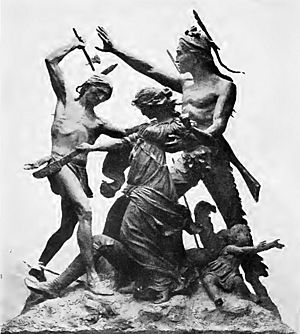Black Partridge (chief) facts for kids
Quick facts for kids
Black Partridge
|
|
|---|---|

Sculpture from the Fort Dearborn Massacre Monument by Carl Rohl-Smith (1893). The sculpture portrays the rescue of Margaret Helm (center) by Potawatomi chief Black Partridge (right).
|
|
| Born |
Makade-bakii
c. 1744 |
| Nationality | Potawatomi |
| Other names | Black Pheasant, Mucketeypokee, Mucktypoke, Mka-da-puk-ke, Muccutay Penay, Makadebakii, Mkadébki, Assikinack |
| Occupation | Potawatomi chieftain |
| Known for | Potawatomi chieftain during the Peoria War; rescued victims of the Fort Dearborn Massacre with his brother Waubonsie. |
| Parent(s) | Wabb-shkum and Mah-jues |
| Relatives | Waubonsie, brother |
Black Partridge (also known as Black Pheasant) was an important Potawatomi leader in the early 1800s. His Potawatomi name was Makadebakii. He was born around 1744 near Peoria Lake, Illinois.
Even though he took part in some conflicts, like the Northwest Indian War and the War of 1812, Black Partridge was known for being a friend to American settlers. He worked hard to keep peace between his people and the United States. He and his brother Waubonsie even tried to protect settlers during the Battle of Fort Dearborn.
Today, a memorial in Chicago, Illinois once featured a statue of Black Partridge. It showed him saving a woman named Mrs. Margaret Helm during the Fort Dearborn attack. A state park called Black Partridge Woods and Partridge Township are also named in his honor.
Contents
Early Life and Peacemaking Efforts
Black Partridge first appears in historical records as a war chief. This was during the Northwest Indian War. He fought under another chief named Matchekewis at the Battle of Fallen Timbers.
After this war, he received a special silver medal. It had a picture of President George Washington. General Anthony Wayne gave it to him at the signing of the Treaty of Greenville in 1795. Another story says General William Henry Harrison gave him a medal with President James Madison's picture at the Treaty of Fort Wayne in 1809. Black Partridge wore this medal for many years. It showed his people's friendship with American settlers.
Standing for Peace
Black Partridge wanted his people to stay neutral during Tecumseh's War. This was a conflict led by the Shawnee chief Tecumseh. In 1810, Tecumseh asked Black Partridge and another chief named Gomo to join his fight. Black Partridge refused.
He told Tecumseh:
I cannot join you. This token was given to me at Greenville by the great chief [Wayne]. On it you see the face of our father at Washington. As long as this hangs on my neck I can never raise my tomahawk against the whites.
Even though Black Partridge wanted peace, he could not stop younger warriors from joining Tecumseh.
Role in the War of 1812
Black Partridge tried to stop the Potawatomi from attacking Fort Dearborn. On August 14, 1812, the night before the attack, he rode to the fort. He returned his peace medal to the fort's leader, Captain Nathan Heald.
He explained his difficult situation:
Father, I come to deliver up to you the medal I wear. It was given to me by the Americans, and I have long worn it in token of our mutual friendship. Our young men are resolved to imbue their hands in the blood of the whites. I cannot restrain them, and I will not wear a token of peace while I am compelled to act as an enemy.
Saving Lives at Fort Dearborn
During the Battle of Fort Dearborn, Black Partridge and his brother Waubonsie worked to protect settlers. They tried to save people from the violence. Black Partridge famously saved Mrs. Margaret Helm. She was the wife of Lieutenant Lenai T. Helm. He held her underwater in Lake Michigan, making it look like he was drowning her. This hid her from other attackers.
He then took her to a nearby Native American camp. There, her injuries were treated. Black Partridge also helped free her husband, who was held captive by the Red Head Chief near Kankakee. He offered his own pony, rifle, and a gold ring as part of the ransom.
Later Conflicts and Treaties
When Black Partridge returned to his village on Peoria Lake, he found it had been burned. Soldiers from Edwardsville had destroyed it. His daughter and grandchild were among those killed.
In response, Black Partridge gathered 200 warriors from nearby villages. He joined an attack against Fort Clark on September 19, 1813. However, the fort's defenders fought them off. Black Hawk, who was a young warrior at the time, also took part in this attack.
Black Partridge and his group eventually surrendered. They were driven back to Fort Clark by General Henry Dodge and Major Zachary Taylor. Black Partridge was one of 13 chiefs taken to St. Louis. There, a peace agreement was signed between the Potawatomi and the United States. He later signed several other treaties with the U.S. government.
In Popular Culture
Black Partridge has been featured in several books, including:
- The Shadow of Victory: A Romance of Fort Dearborn (1903) by Myrtle Reed
- When Wilderness was King: A Tale of the Illinois Country (1904) by Randall Parrish
- Black Partridge, or the Fall of Fort Dearborn (1906) by H.R. Gordon
- Wolves Against the Moon (1957) by Julia Cooley Altrocchi
- Fort Dearborn: A Novel (2006) by Jerry Crimmins

